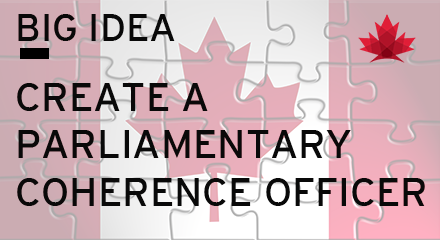 In June, Canada 2020 launched The Innovation Project, an initiative devoted to studying Canada’s innovation agenda – the risks, the opportunities, and key factors involved in making Canada a more innovative nation.
In June, Canada 2020 launched The Innovation Project, an initiative devoted to studying Canada’s innovation agenda – the risks, the opportunities, and key factors involved in making Canada a more innovative nation.
As part of this project, we asked Mike Moffatt, Senior Associate at Canada 2020 and Director at the Lawrence Centre at Western University’s Ivey Business School and Hannah Rasmussen, Director at Projection North and Professor at Western University’s Brescia College, to consider how to foster innovative growth in Canada.
Moffatt and the Canada 2020 team traveled to eight cities across Canada to hold roundtable discussions with key stakeholders representing sectors ripe for transformation. We are grateful for the thoughtful discussion and time these roundtable participants gave the effort. While the sectors themselves were very different, common themes emerged: talent and immigration, availability of venture capital and Canadians’ adversity to risk.
From their research and these roundtables, Moffatt and Rasmussen developed 10 Big Ideas for Canada. Canada 2020 will be releasing an idea a day on our website leading up to our 3rd Annual Canada 2020 Conference: The Innovation Agenda.
Each idea is thoughtful and detailed, and Canada 2020 hopes they will spur discussion and debate on the topic as we continue to explore innovation in Canada.
—
Big Idea: Thicken Labour Markets
What is the idea?
In early 2015, the Mowat Centre assembled a roundtable of executives from the emerging information and communications technologies sector in London, Ont., and asked them about their bottlenecks to growth.(1) They identified attraction to and retention of talent in London as their most pressing challenge. Talented technology workers told companies they were reluctant to move to or stay in London for two reasons:
- There are a limited number of information and communications technologies companies in the London area, so if they ever needed to change jobs, they were concerned they would not be able to find employment quickly in the city.
- Whiletheycouldfindmeaningfulemploymentinthecity,they were part of a“power couple” and had concerns about their spouse’s ability to obtain a good job locally. In most cases, the spouse was highly educated and had a very specific skill set valued by only a handful of employers.
Both of these problems are ones of thin labour markets with only a handful of buyers and sellers. Thin labour markets are often self-perpetuating. A limited number of firms causes talent to migrate out of a centre, preventing new firms from emerging, causing a further erosion of talent from the market.
The “power couple” issue of both individuals having employment opportunities is a particular concern for mid-sized cities. In a seminal 2000 piece, Dora Costa and Matthew Khan examined the migration patterns of college-educated Americans between 1940 and 1990.(2) They found significant “power couple” migration to large centres (defined as cities over two million in population). In 1990, 50 percent of all dually college-educated couples lived in the cities, compared with 32 percent in 1940. Contrast this to the proportion of couples where neither had college educations, which had only modest growth in the period (from 27 percent in 1940 to 34 percent in 1990). Power-couple migration to large cities is not simply due to the college educated (regardless of their relationship status) migrating to larger centres; Costa and Kahn estimate that “coincidental couple concentration suggests that at most 35 percent of the increase in power-couple concentration in large cities is attributable to the growing urbanisation of the college educated.” Ultimately, families matter and drive location choice.
In our view, this leaves Canadian governments with two options:
- Focus its innovation agenda on the three census metropolitan areas with more than two million people (Toronto, Montreal and Vancouver) and recognize that, as it stands, labour markets are too thin in other Canadian cities to support sustainable clusters except in unusual cases. Develop a suite of policies that addresses the issues inherent in further migration to big cities (rapidly rising real-estate prices, lack of affordable housing, traffic gridlock and overstretched transit systems) as well as the issues inherent in de-populating secondary centres (falling property values and a shrinking tax base’s inability to properly service the existing stock of infrastructure).
- Actively work to “thicken” labour markets in mid-sized cities, which will allow for the emergence of clusters in these cities.
In our view, the government should take the second approach, while recognizing that “the big three” will continue to grow and have the challenges associated with growth.
In the global war for talent, workers will migrate to areas that give them the most career opportunities. As non-compete agreements limit career opportunities, talent will naturally migrate to jurisdictions that lack such agreements. One example is California, where non-compete clauses are invalid and unenforceable unless they fall under some very specific exemptions,(3) which is oft-cited as a major factor in the success of Silicon Valley’s technology sector.(4) Or as Bijan Sabet, a general partner at Spark Capital told Fortune, “If you’re a graduate of MIT who studied a specialty like robotics and a Massachusetts company says, ‘Come here and sign this non-compete,’ and a San Francisco company says, ‘We know this isn’t your last job — do whatever you want,’ which would you choose?” (5) Peer-reviewed studies back up this phenomenon, with Matt Marx, Jasjit Singh and Lee Fleming finding that “non-compete agreements are responsible for a “brain drain” of knowledge workers out of states that enforce such contracts to states where they are not enforceable. Importantly, this effect is felt most strongly on the margin of workers who are more collaborative and whose work is more impactful.” (6)
A 2016 study by the U.S. Department of the Treasury on the economic impact of non-compete contracts found that “the effect of maximal enforcement of non-compete contracts, relative to minimal enforcement, is five per cent at age 25 and 10 per cent at age 50.” (7) The Treasury study also found that California’s restrictions on the use of non-compete clauses both thickens labour markets and increases innovation through a process of knowledge diffusion. They find that “employee departures impose costs on their firms, but yield benefits for destination firms and act to broadly disseminate improvements in technologies and best practices. Non-compete enforcement can stifle this mobility, there by limiting the process that leads to agglomeration economies.”
While non-compete clauses are often difficult to enforce in Canada (putting us closer to the minimal enforcement end of the spectrum), no province has gone as far as California and simply banned the use in most instances.(8) We would advocate that provinces consider doing so. Explicitly banning non-compete clauses would create less uncertainty of the rights of workers, increase worker mobility and help Canada attract and retain talent. Such a ban would likely lead to higher wages in many industries, so naturally firms will raise concerns about the effect even modestly higher wages will have on their competitiveness. Given that higher wages will lead to attraction and retention of talent in Canada and incent more students into entering innovative fields, we believe it is a price worth paying. Finally, given that we are trying to create economically inclusive innovation, we see higher wages that are driven by market forces as a feature, not a detriment.
An obvious way to address the thin-market problem is through linking mid-sized cities through intercity transit. Consider London, Ont. London’s Census Metropolitan Area (London CMA) has a population of just under 500,000, which includes the city of London, the city of St. Thomas and rural areas and towns around London. The CMA is simply too small to have a significant number of jobs in every occupation, limiting opportunities for couples that work in two different occupations. Furthermore, individuals might be hesitant to take a job in a community with a small number of companies in that same industry. A large number of companies in an industry creates an “option value” for a worker; if they need to leave their job at their existing company, there are plenty of alternatives, which should make it relatively easy to switch companies. However, if there are few local companies in their industry, then workers are “locked in” to their current employer and risk prolonged unemployment should they leave that employer. This potential for “lock in” and unemployment creates significant risk for workers considering taking a position in that community. This problem is particularly acute for ‘power couples,’ where employment options for two people have to be considered.
This thin market problem has a straightforward solution. If it is easy and inexpensive to live in one community but work in other, then the effective population of the community (and its clusters) grows. Consider all of the Census Metropolitan Areas (CMAs) and Census Agglomerations (CAs) of population sizes of 75,000 or more, within 200 kilometers of London, Ont.
|
Community
|
Population
|
|
London CMA
|
474,786
|
|
London CMA + &75K CMA/Cas Less Than 100km aWay
|
1,177,002
|
|
London CMA + &75K CMA/Cas Less Than 150km Away
|
2,143,227
|
|
London CMA + &75K CMA/Cas Less Than 20km Away
|
8,437,721
|
If Londoners can easily, affordably and reliably get to employment opportunities within 100 kilometres of the CMA, the effective size of London’s employment market grows to almost 1.18 million people by adding the Kitchener-Cambridge-Waterloo CMA (population 477,760), the Brantford CMA (135,501) and the Sarnia CA (89,555).(9) Make the radius 150 kilometres, and the market size nearly doubles to 2.14 million by adding the Hamilton CMA (721,053), the Guelph CMA (141,097) and the Chatham-Kent CA (104,075). Finally, a travel radius of 200 kilometres creates an effective market of more than eight million by adding the Toronto CMA (5,583,064), the St. Catharines-Niagara CMA (392,184) and the Windsor CMA (319,246).
Currently, an individual in London who wishes to take a job in one of these communities (or an individual in one of these communities who wishes to take a job in London) can only commute by car unless they have an incredibly flexible work schedule. This time by car is essentially wasted time, where the individual is away from family and cannot work because they are driving. Taking a train or a bus, on the other hand, allows individuals to complete work while they commute. Unfortunately, the earliest a Londoner can arrive at Toronto’s Union Station by train is 8:35 a.m., assuming the train is on schedule. These time limitations makes commuting by train impractical for jobs that involve morning meetings. The situation is worse for commuters taking the opposite trip, as someone living in Toronto cannot arrive in London until 9 a.m. at the earliest. On the return trip, travellers to London or Toronto must leave before 8 p.m., which makes attending dinner meetings difficult.
Increased and more reliable train service, with earlier and later options than currently offered, would significantly help thicken mid-sized markets. Given the challenges these cities are currently experiencing, we recommend this happen as soon as possible. While high-speed rail is a fantastic technology, these cities do not have 15 years or more to be connected to each other, so we recommend enhanced investments in existing transportation technologies happen as soon as possible.
Mid-sized and smaller markets not only have challenges moving people, but also moving data at the speeds necessary for global commerce. These challenges will only be exacerbated with the introduction of 5th Generation (5G) wireless technology. 5G will act as the backbone for everything from the Internet of things (IoT) to driverless cars. However, given large capital costs and the positive network externalities generated by 5G, without smart public policy, the market is likely to under-invest in 5G infrastructure.
Finally, clusters in all-sized markets could be thickened by ensuring that no Canadians are excluded from employment opportunities in clusters due to “socially determined exogenous factors, such
as gender, race or socioeconomic background, beyond an individual’s control.” (10) The first step to addressing barriers to exclusion is having better data so we can determine their root causes. These root causes could include those with the proper skills lacking employment opportunity as well as individuals being unable to obtain the skills they need, which leads us to the following two recommendations:
What mechanisms for accountability or measurement can be put in place for the idea?
No new mechanisms are needed, as this idea mostly involves governments doing more of what they already do (transit funding, data collection). Changing rules around non-compete agreements is a one-time activity.
What failures is the idea trying to solve?
Thin Markets: This proposal is explicitly designed to thicken markets, as the goal is to increase the pool of available workers for hire in fast-growing clusters.
Inequality of Opportunity: This idea increases opportunities for those who get left out of clusters, either due to geography (lack of transit) or because they belong to a traditionally under-represented group.
What are the potential benefits of the idea and what are the costs?
Benefits: Thicker, more-inclusive clusters create economic wealth and opportunities for all Canadians.
Costs and Risks: Transit is extremely expensive to build, so there is a risk that the benefits do not outweigh the costs. Statistics Canada could have difficulties collecting the needed data because of privacy concerns or budget. Finally, a lack of non-compete agreements could deter companies from supplying worker training.
Will the idea increase economic inclusion and/or enhance autonomy? If so, how?
Economic Inclusion: Allowing people to live farther from work increases their affordable housing options as they are not “forced” to purchase expensive housing if they work in an expensive city. Thickening markets in mid-sized cities will lead to spin-off job creation in those centres, which too often have seen job loss- es through automation and globalization. Finally, a focus on increasing labour market opportunities for excluded groups increases their ability to access good paying jobs.
Autonomy: Increased intercity transit increases autonomy for individuals, as it increases the number of places they can gain employment (or live). It increases their ability to stay with and see a partner who works in a different city. It provides additional opportunities for places to travel to and people to see.












